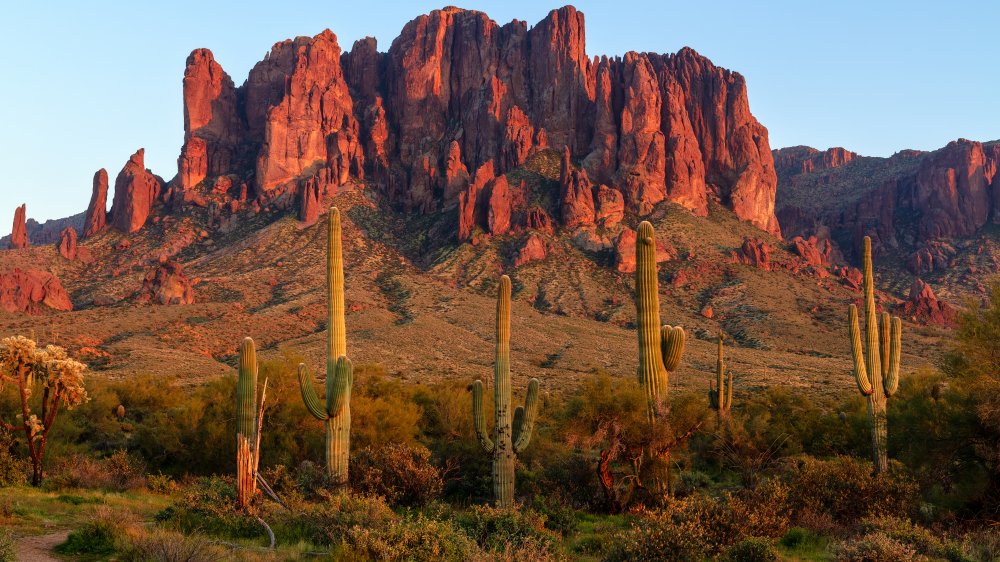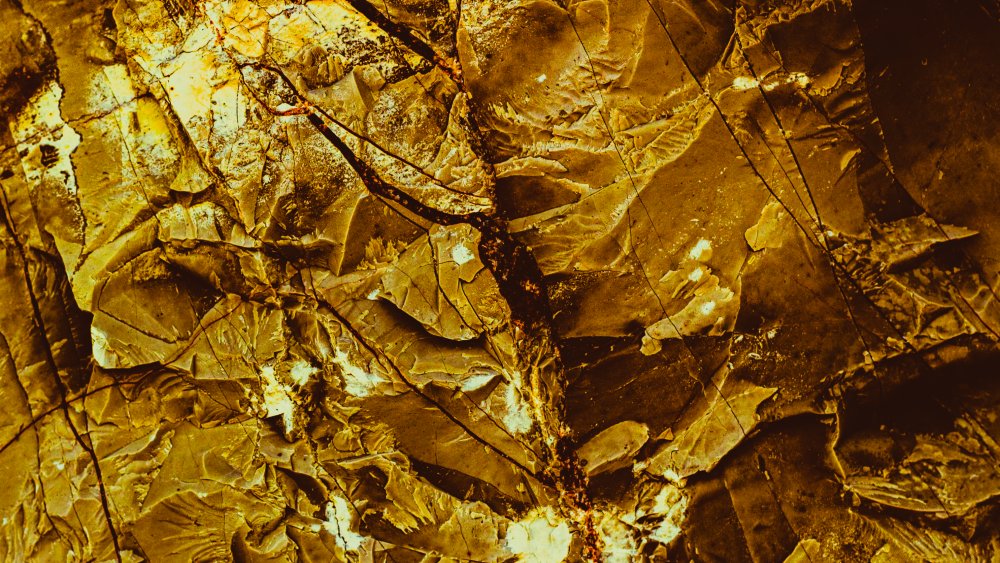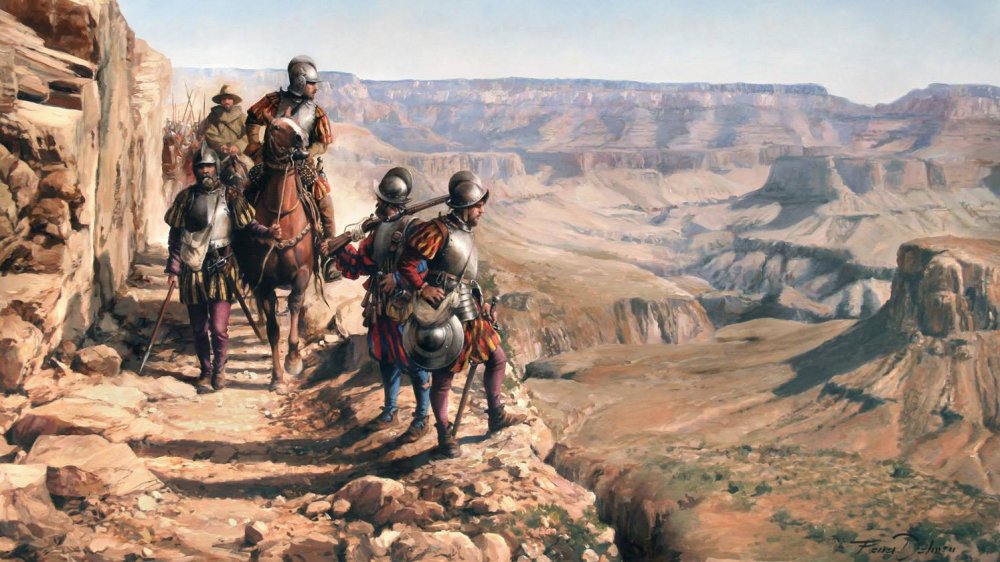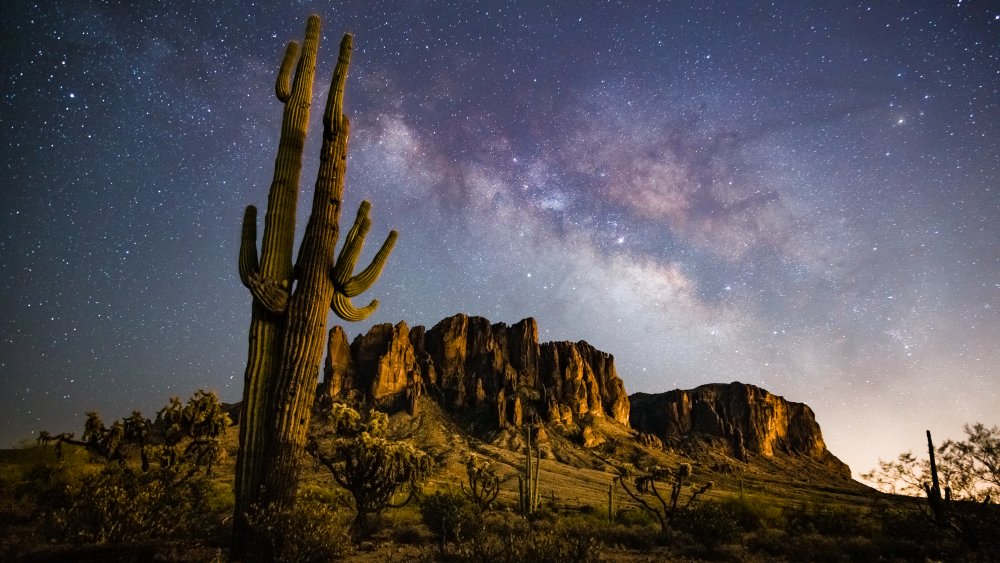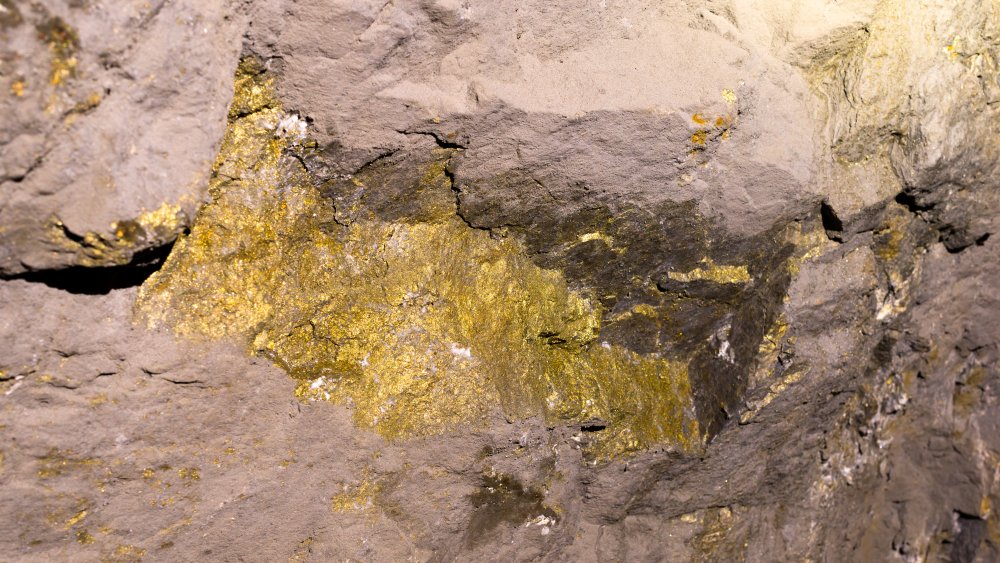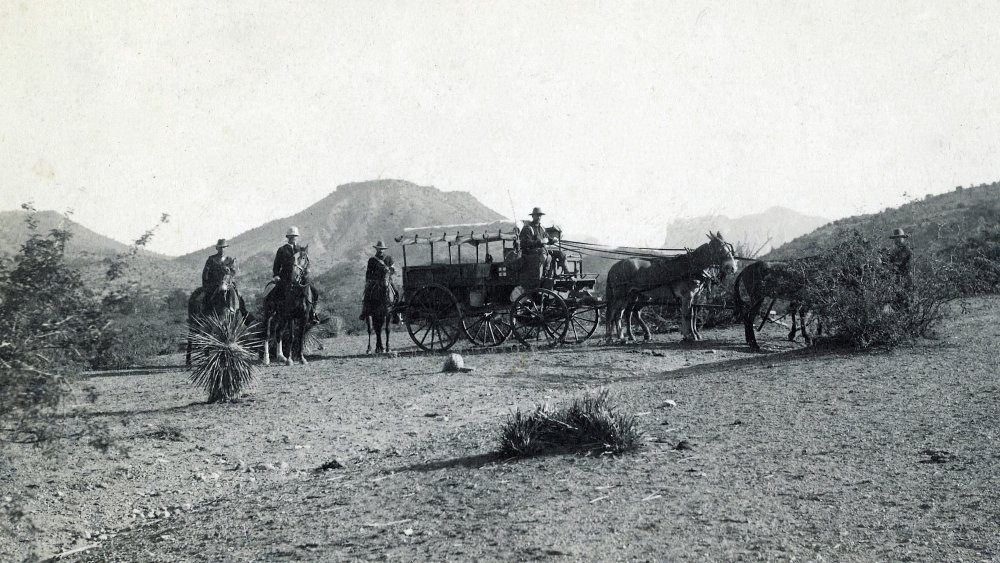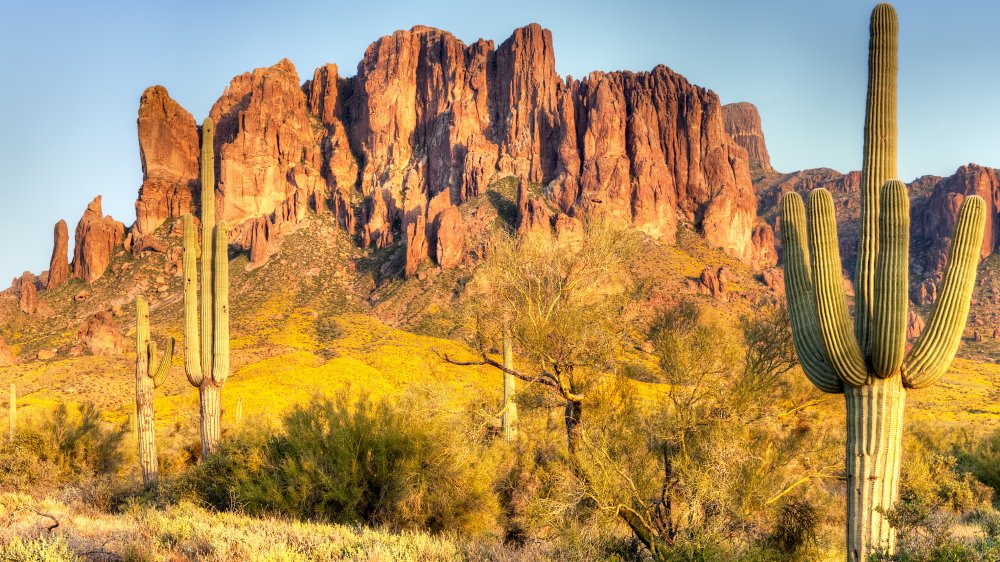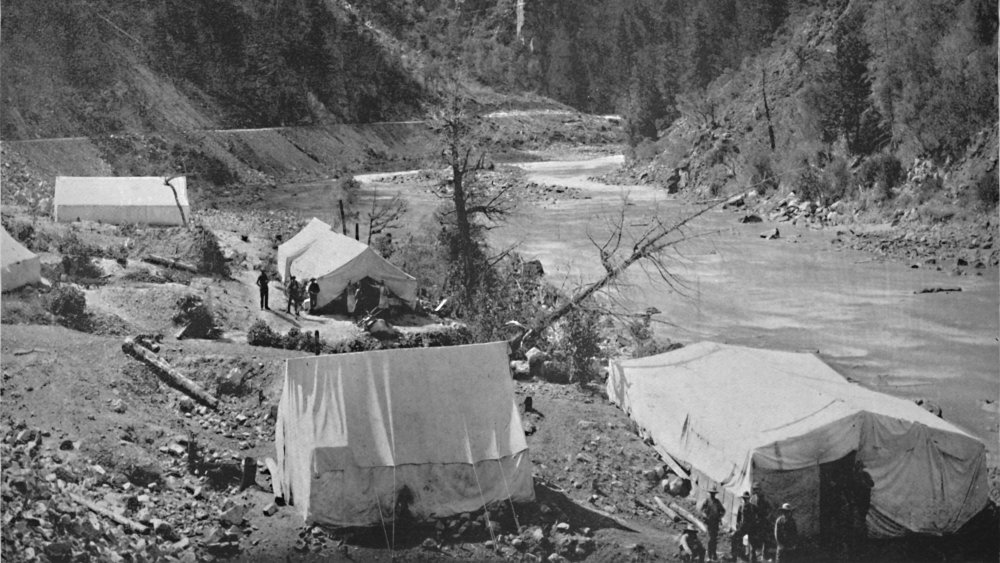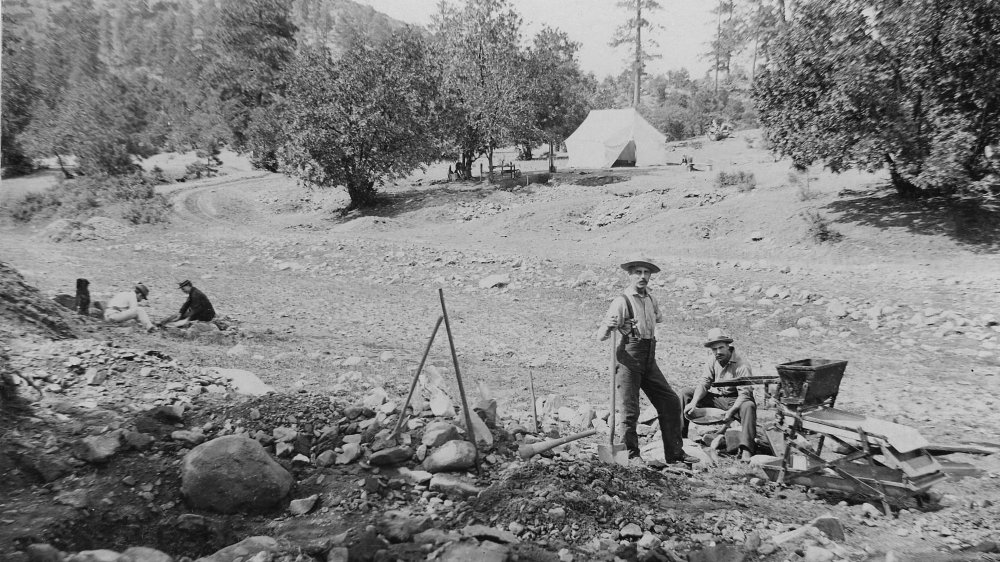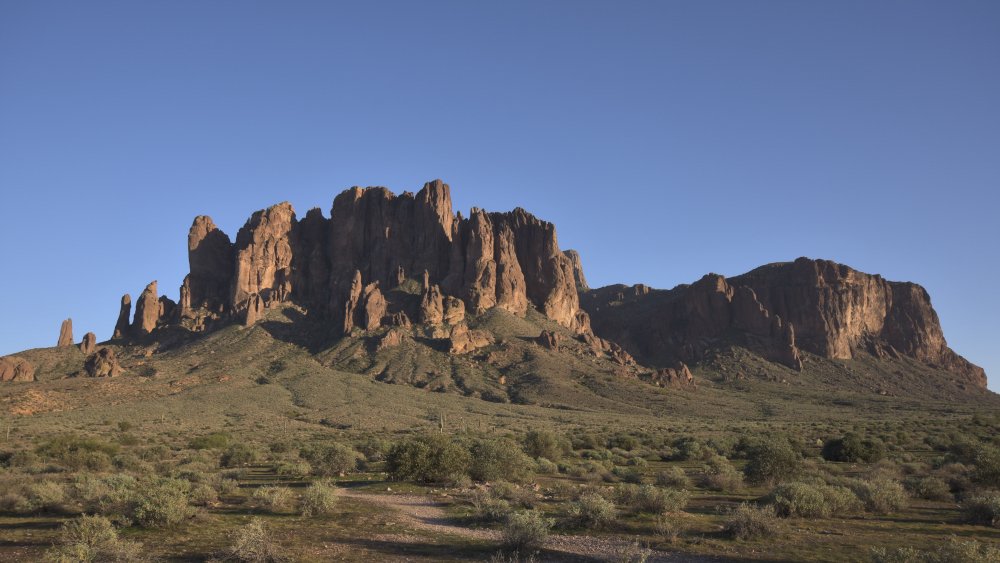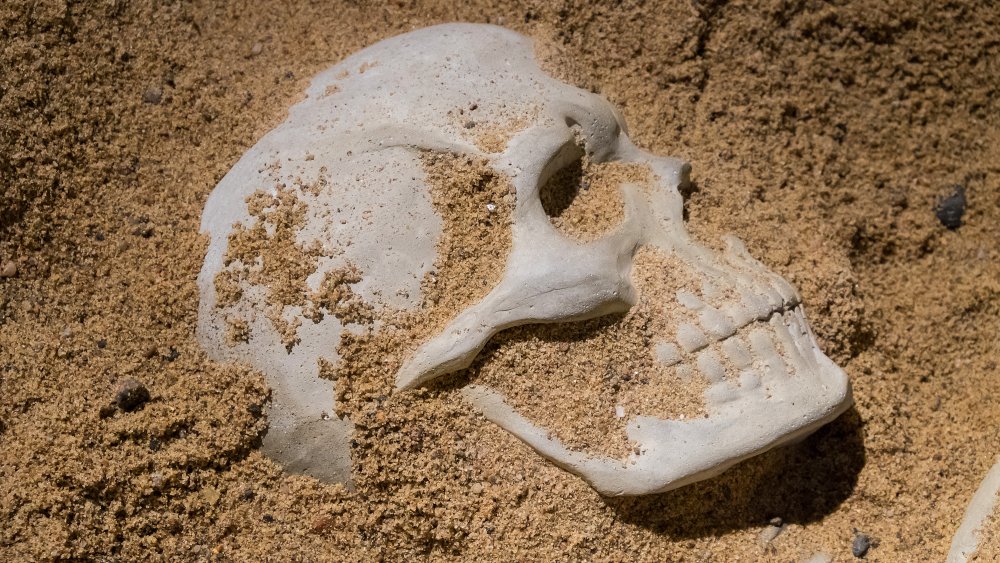The Legend Of The Lost Dutchman And His Gold Mine Explained
Everyone loves a good treasure hunting story. It's an entire genre all its own, from pirate maps to all the stuff Nicolas Cage got up to in the National Treasure movies. There's the thrill of the hunt, solving the clues, and what could be a better payoff than a big cache of riches?
Humankind has been enthralled by lost treasure legends for ages. Great discoveries have been made in the name of hunting for hidden wealth, but much blood has been shed in those same pursuits, too. That's not even counting those hunting the treasure in the ensuing years.
The legend of the Lost Dutchman's gold mine is a quintessential version of just such a story. It involves murder, secrets, and a whole lotta sweet, sweet gold. For over a century, treasure hunters have sought the treasures supposedly lost in the Superstition Mountains of Arizona, but what do we really know about the events surrounding this tale?
The Lost Dutchman's treasure hunt
Let's start with the basics. According to legends, a man named Jacob Waltz, the titular Dutchman (though he was actually German and not Dutch), came to America to seek out his fortune around the 1860s, according to Lost Dutchman State Park. The Gold Rush was in full swing and Waltz wanted a piece of those potential fortunes. While he allegedly worked as a miner at numerous mines earlier in his life, eventually Waltz decided he wanted to prospect on his own.
This is what brought him to the Superstition Mountains (yes, that's their real name) near what is today the city of Phoenix, Arizona. As the story goes, Waltz had some minor success drawing gold out of the mountains, and eventually, he started coming back to town with huge loads of high-grade gold ore. Apparently, Waltz began to hint he knew of a secret gold vein hidden in the mountains, even giving out a few clues to its location.
Waltz died in 1891 of pneumonia, but before he passed, he gave a few final clues to the location of his mine and even provided a crude map to it. However, even armed with the clues and map, no one in the area could find the Dutchman's mine, thus giving it the name of the Lost Dutchman's gold mine.
The Dutchman wasn't the first to come seeking gold
The Lost Dutchman mine is far from the beginning of the legends of gold hidden in the Superstition Mountains. There's another story that supposedly took place three centuries earlier also involving a treasure stashed away in the area. According to the tales, a Spanish conquistador (often said to be Francisco Vazquez de Coronado, but sometimes reported as any number of other explorers, real and fictional) came to the Superstition Mountains in the mid-1500s searching for a mythical city of gold, one of the legendary Seven Cities of Gold, somewhere in the mountains, according to Legends of America.
The conquistador and his men arrived and made their way deep into the mountains, despite the warnings of danger from the local Apache. However, things started going wrong immediately as men began to disappear, later being found decapitated. The conquistador ordered the men to stay close together so they weren't picked off, but this didn't help. Eventually, the conquistador ordered his men to flee and he never returned to the mountains, which they called Monte Superstición, thus giving the mountains the name of Superstition.
Further legends claim the conquistador and his men were bearing their own reserves of gold, looted from previous expeditions, but ended up leaving it behind when they escaped whatever was killing them. Sometimes, this discarded cache of gold is said to be the origin of Jacob Waltz's treasure. Waltz found it in the mountains and came to grab gold out of it as needed.
The land was supposedly the residence of a god
So who killed the Spanish treasure hunters that came to the land? That, in and of itself, is a separate legend. Supposedly, the Superstition Mountains have long been a sacred site for the nearby Apache tribe of Native Americans. (In truth, Apaches make up just one of the tribes found in the area, but these were typically all lumped in as "Apache" by white settlers who didn't appreciate the differences in Native American tribes.)
According to Legends of America, the Native Americans in the area believed the Thunder God of their religion lived in the Superstition Mountains, and thus they were required to protect it with lethal force, killing any who might set foot on the mountain and disturb their deity. Not only that, but some legends claim there were a number of shrines in the mountains filled with gold meant to be an offering to the Thunder God.
In some versions of this story, Waltz was actually plundering these shrines for his own gold. While a few versions have Waltz outright stealing the gold, in other versions, he either rescued or fell in love with an Apache woman who shared the secret of a gold vein her people had been mining for centuries, but as punishment for sharing the knowledge with an outsider, her tongue was cut out, ensuring she could never speak again.
A group of priests left a massive trove of gold in the mountains
These Native American legends aren't the only tales involving religion and gold stores in the area. Indeed, there's yet another legend purporting to explain where the Dutchman might have acquired his gold. The story goes that in the mid-1700s, the Superstition Mountains were visited by a group of priests of the Jesuit Order, and they came with over 240 mules loaded down with gold, according to the Denver Post.
The Jesuits, who had been collecting the gold for many years from various sources, were said to be fleeing as they had been expelled from the Spanish empire, who owned most of the land that would eventually become the southwestern United States at the time, according to the Great American History Blog.
Allegedly, people saw the Jesuits come up to the Superstition Mountains with their loads of gold, but when they were spotted again on the other side, the mules carried no loads. Thus, it seems these Jesuit priests might have stashed their treasure somewhere in the mountains as they passed through, thus ensuring the Spanish empire couldn't get their hands on the Jesuit fortune. While the Jesuits were eventually allowed to return to the area, it seems they either forgot the treasure or couldn't find it, and so it was still in the mountains when it was perhaps discovered by none other than the Dutchman himself, Jacob Waltz.
A rich family was supposedly massacred in the Lost Dutchman's goldmines
After the conquistadors and priests are purported to have come and gone from the Superstition Mountains, legend tells of another group who arrived sometime in the earlier half of the 1800s. The exact year varies, but the story goes that a rich Mexican mining family named Peralta also came to the area in search of gold. They found what they were looking for and then some, according to Lost Dutchman State Park.
Supposedly, the Peraltas actually found a very rich gold vein and set up a mining operation. They came back from the mountains hauling a lot of gold and saying there was far more from whence it came. However, they eventually disappeared after a trip into the Superstitions. When the townspeople went to look for them, they found nearly all of the family slaughtered. Only one (sometimes two) could not be accounted for. The story sometimes claims there were arrows all around, and so thus it must have been the Apache protecting their sacred mountains.
The legend then states that, sometime later, the last Peralta survivor(s) were helped out of some kind of bind by Jacob Waltz, and in his debt, they gave him the only thing they had of value: a map to the Peralta family mine in the Superstition Mountains, according to Cowboys and Indians magazine. This, of course, is how the Dutchman is supposed to have really found his treasure.
There are numerous other legends of the Lost Dutchman's gold
Except perhaps not. There are other legends about gold in the Superstition Mountains. In the first, a doctor (sometimes said to be an Army doctor) called Dr. Thorne was said to have had a Native American man who needed medical assistance brought to him. In some versions, he's not just a man but the chieftain of the Apache tribe. Regardless, Dr. Thorne helped the man and he recovered, according to Legends of America.
As a reward, Dr. Thorne was blindfolded and led to a cave in the mountains. There, his blindfold was removed and he saw a cave full of gold. The man said Dr. Thorne could take as much as he could carry, at which point he was blindfolded again and led out. Allegedly, Dr. Thorne tried to find the cave again but was unsuccessful, or found it and was killed.
In an addition to this legend, it's claimed two soldiers came to the Superstitions after hearing of Dr. Thorne's story to see if they could locate the cache. They supposedly did and brought a good amount of gold back to town according to Tom Kollenborn Chronicles. They planned to return, but once they left, they were never seen again. Both of these legends are sometimes set before the Dutchman arrived in Arizona, but some time afterward, and thus Dr. Thorne and the soldiers may have stumbled across the Lost Dutchman's mine.
The Superstition Mountains are geologically unlikely to have gold
So what do we really know about these legends, Waltz, and the Superstition Mountains? First, let's talk about the geology of the mountains. We know today they're not actually sedimentary rock, but volcanic, according to Lost Dutchman State Park. While this doesn't mean it's impossible there's gold to mine up there, it makes it far less likely. Perhaps this is why many of the legends involve people bringing gold to the mountain and leaving it hidden there.
Still, this doesn't dissuade treasure hunters. There's even been a ban on mining in the Superstition Mountains since 1984 due to the number of people coming and getting killed in mining accidents searching for the Lost Dutchman's gold.
It's also worth noting the mountains aren't known to have gotten their ironic name from any of the above legends. Researchers point to an old belief by local farmers that the nearby Pima Native American tribe were superstitious about the mountains. None of the tribes in the area ever considered the mountains to be sacred, and while the Apache tribe does have a thunder deity in their religious beliefs, they don't claim he lives in the Superstitions. This seems to have been made up solely for the various legends, according to Tom Kollenborn Chronicles. It appears no one ever bothered to just ask the Native Americans in the area if the mountains were sacred.
Who was Jacob Waltz, the Dutchman?
So what about Jacob Waltz? Surprisingly, he was a real man. He really did emigrate from Germany, though this seems to have occurred decades before the legends claim, because there are verified documents showing he filed to become an American citizen in 1848, long before he supposedly arrived in 1860, according to the Superstition Mountain Museum. He really did die in 1891 of pneumonia. He even has a gravesite you can visit today in Arizona.
But there's no evidence he was any sort of engineering or mining genius like some legends claim. He had worked as a miner but was an amateur prospector at best. Also, there's no documentation showing he ever filed a claim for a mine in the Superstitions or any paperwork showing where he allegedly sold mass amounts of gold. What there is documentation to support is that the Dutchman may have been a con man. There's some evidence to suggest he engaged in a shady practice called highgrading — basically claiming ore is more valuable than it really is.
None of this rules out that he simply found a cache of abandoned gold, of course, and when he died, he did have in his possessions some high-grade gold ore, though its value is unclear and it may have just been for attracting potential investors in his prospecting operations.
Where the legends of the Lost Dutchman's mines fall short
And now we get to the real problem with these legends — there's basically zero evidence any of them ever happened. The stories of conquistadors and Jesuits bearing gold are completely unverifiable without documentation or archaeological evidence. While Francisco Coronado did exist and did explore what is now the southwestern United States, there's nothing indicating he ever visited the Superstitions. Also, as previously mentioned, no Native American tribes in the region seem to have any history of treating the mountains as anything other than regular mountains.
It seems likely there was no Dr. Thorne, but there was a doctor in New Mexico who told a similar tall tale, except he was kidnapped by the Navajo tribe in his story. It's likely this legend just got re-adapted to the Superstitions to boost the legend of the Lost Dutchman's mine. There are lots of similar tales of gold-hunting soldiers, too, from all over the southwest. Even if the stories of soldiers looking specifically for the Lost Dutchman mine are true, there's no evidence they actually found anything at all and didn't just move on empty-handed, no mysterious deaths required.
Finally, there really was a successful gold mining family named Peralta, but they were in California, not Arizona, according to Gold Rush Nuggets. There's no evidence they ever came to Arizona at all.
The origins of the legend of the Lost Dutchman's gold mine
So where did all these rumors of lost gold in the Superstition Mountains originate? It's impossible to know for certain, but there is one big clue. It's unclear if Waltz himself ever specifically claimed to have a secret gold mine in the mountains, but one woman said he did claim just that — Julia Thomas, Jacob Waltz's friend and neighbor, according to Skeptoid.
Julia, whose occupation is sometimes listed as a nurse and sometimes as a baker, took care of Waltz late in life and the two became close friends. According to Thomas, it was on his deathbed that Jacob Waltz shared the story of his secret mine, and even provided a map to it filled with clues. In fact, Julia Thomas was the very first so-called "dutch hunter," combing through the mountains and seeking the lost gold.
However, despite bankrupting herself and spending a very long time in the mountains, she and her search party never found any evidence of a hidden gold cache, per Arizona Report. To recoup the costs of the search, Julia Thomas actually began to make handmade copies of Waltz's map and sell it to others.
About that map to the Lost Dutchman's mine
Here's the thing about the Julia Thomas map to the Lost Dutchman's gold mine, which is still sold and used today: Jacob Waltz didn't actually draw it. Thomas admitted she drew the map herself but claimed she based it on descriptions given by the Dutchman, according to Skeptoid.
The map is supposedly filled with clues, and there are many others purportedly given by Waltz at various points in his life according to legends, but it's hard to prove he actually ever said any of those things. It's very possible the clues are also unverifiable legends people have clung on to in hopes of finding riches.
It seems likeliest one of two things happened. Waltz did claim to have a treasure, but he really didn't and was simply telling tall tales to make his life seem more interesting, then Julia Thomas believed him. Or, he never made any such claims at all and Thomas made up the whole story based on some gold ore she found in Waltz's possessions. Either way, she went to the mountains for a while to search. It's not even out of the question the expedition was a misdirect to make it seem like she and her cohorts were looking for something to bolster the legend. Then, she took the map that was either from Waltz's imagination or her own and made a whole lot of money selling copies of it.
People have died seeking out the Lost Dutchman's treasure
Since Jacob Waltz's death, thousands of people have searched all throughout the Superstition Mountains for the location of the Lost Dutchman's gold mine, to no avail, according to USA Today. A not-insignificant number of those Dutch hunters have gotten hurt or even killed. Official estimates vary (the Superstition Mountains are also a popular hiking area and sometimes it's likely difficult to tell if someone was just hiking and got lost or was looking for the Lost Dutchman), but there are at least some every decade.
Take, for example, the story of Adolph Ruth, an experienced treasure hunter who typically worked with his son, Erwin. In 1931, the two sought the Lost Dutchman's gold mine, but Adolph Ruth, against his son's wishes, went looking alone, according to Skeptoid. He never returned, and months later, an archaeological expedition encountered his remains, which indicated he had been shot, and a hand-written note claiming he had found the entrance to the mine.
Unfortunately, when a group followed the clues given in Ruth's letter, they found nothing. Once again, only rumors kept the legend alive, and these events drove even more Dutch hunters to the dangerous mountains. What really happened to Ruth? Is it possible he took his own life? No one knows for sure, but his disappearance and death, while better-documented than other legends revolving around the Lost Dutchman's gold mine, may have simply furthered the legend and put even more treasure seekers in danger.
